
Sunrise at 36,000 feet |

The Pagasetic Gulf of Greece |

On approach for Athens, Greece |

Leaving the Airport in Athens, Greece |

Hotel Grand Bretagne in Athens was built in 1842 |

In 1874, the property was restored and named 'Grand Bretagne' |

The Hotel Grand Bretagne hosted dignitaries for the 1896 Olympic Games |

'Evzones' are members of the Presidential Guard in front of the Grrek Parliament Building |

The Tomb of thw Unknown Soldier stands in front of the Greek Parliament |

Changing of the Guard at the Tomb of the Unknown Soldier in Athens, Greece |

The uniform of the Evzones evolved from the highwaymen who fought the Ottoman Turks |
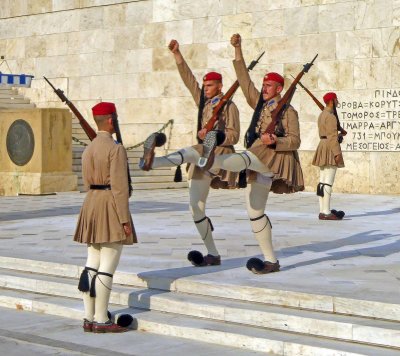
The shoes (clogs) of the Evzones weigh over 7 pounds |

First stop on our Athens Wine & Food Tour |

The only wine Susan really liked |

Little Metropolis formally the Church of St. Eleutherios is a Byzantine Church in the heart of Athens |

The Metropolitan Cathedral of the Annunciation (1862) in Athens |

Our tour guide demonstrating 'the magic of Ouzo' at dinner |

Our Athens Wine & Food Tour group |

Two of thirteen Greek dishes for dinner |

Passing the 'Little Metropolis' at night. Eleutherios is a Byzantine Church |
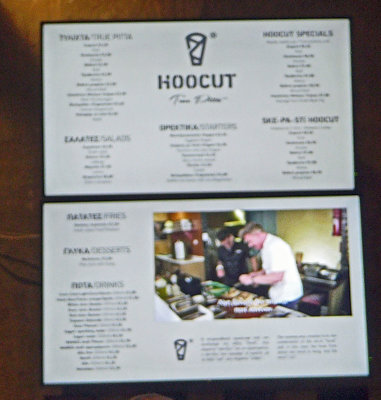
Hoocut Pitta (Souvlaki) was featured on Gordon Ramsey |

Cooking at Hoocut |
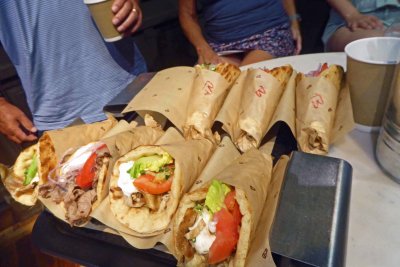
Souvlaki is typical Greek Street Food |

View of the Athens Acropolis for the Grand Bretagne rooftop bar |

Byzantine architecture in Athens, Greece |

Academy of Athens (1859-85) is part of the Athenian Trilogy of Neoclassical architecture |

The Academy of Athens was built to resemble the Propylaea of the Acropolis (gateway to Acropolis Hill) |
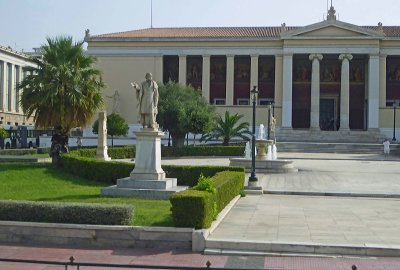
The old University of Athens is the second of the Athenian Trilogy |

The National Library of Greece completes the Neoclassic Athenian Trilogy |

Memorial of National Reconciliation in Athens |

The Old Parliament House in Athens housed the Greek Parliament between 1875 and 1935 |
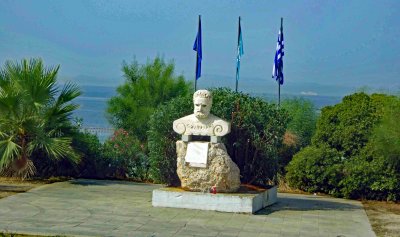
Driving south along the coast from Athens, Greece |

Greeks swimming in a rocky cove of the Aegean Sea |

Greeks enjoying the Aegean Sea on a Sunday |

Sunday on the coast of Greece |

Saronic Gulf of Greece |

Fish farm on the Saronic Gulf |

Cape Sounion is the southernmost tip of the Attic peninsula in Greece |

Cape Sounian controlled access to the Aegean Sea and the port of Piraeus as early as 6th century BC |

The temple of Poseidon at Sounion was constructed in 444–440 BC |

The Temple was built to honor Poseidon, god of the sea |

Only 15 of the 34 original Doric columns are still standing today. The columns are of the Doric Order |
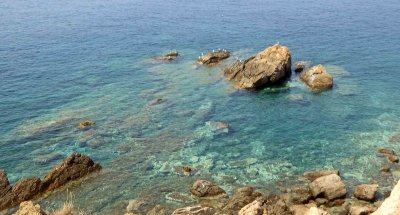
Rocky cove near the location of two ship sheds in 413 BC |

Remains of the settlement for 2nd-3rd Century BC |

Remains of a fortress from Peloponnesian War (413 BCE) |

The path Bill chose to take instead of the steps |

Village Greek Orthodox Church |

Back in Athens, Greece |
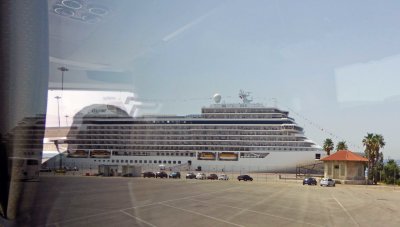
Regent Seven Seas Explorer at the port of Piraeus, Greece |

Suite 753 on Regent Seven Seas Explorer |

Pre-stocked bar in our cabin |

The biggest walk-in closet we've seen on a ship |
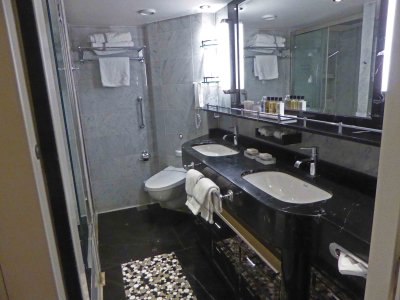
Double sinks always make life easier |

Champagne on the balcony |

Balcony view at the port of Piraeus |

On our way to dinner at Sette Mari specialty restaurant |

Pool deck on the Regent Seven Seas Explorer |

A huge veal parmesan |

Found people to party with on day 1 |

Deck 4 outside the Casino |

Mykonos (island), Greece |

Two impressive yachts in Mykonos |

Starting our tour of Mykonos |

Fishing boats in Mykonos |

Fishermen in Mykonos |

Mykonos Town Hall was built in 1785 as a residence for a Russian Count |
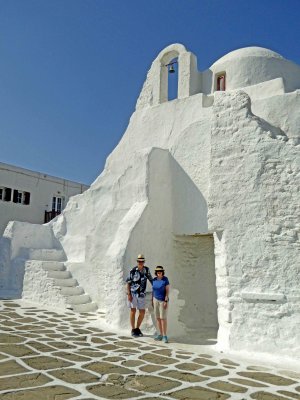
Paraportiani consists of five churches started in 1425 |

Clear waters of the Aegean Sea & WIndstar ship at anchor |

Neighborhood of 'Little Venice' in Mykonos began in the 13th Century |

On the streets of Little Venice in Mykonos |

Remains of the Castle of Mykonos (1207) |

Mykonos is famous for its 16th Century Windmills |

Mykonos Windmills were primarily used to mill wheat until the 20th Century |
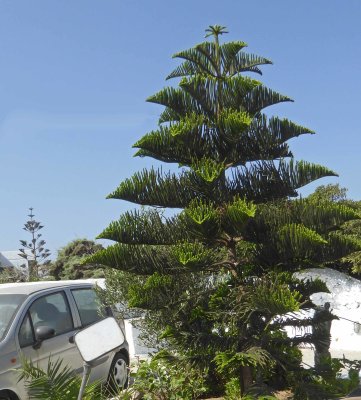
Norfolk Island Pine on Mykonos |

Motorbike parking on Mykonos |

The Island of Delos is the mythological birthplace of Apollo and Artemis |

Monastery of Panayia Tourliani (16th Century) in Ano Mera, Mykonos |

Inside the Monastery of Panayia Tourliani on Mykonos |

The Monastery is named for the icon of the Virgin Mary found near Tourlos |

The altar screen in the monastery was made by Florentine artists in 1775 |
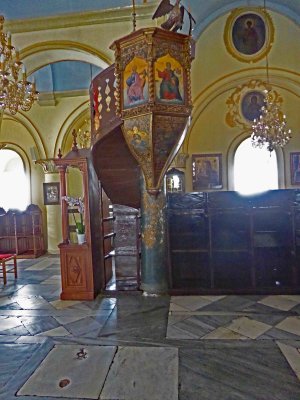
Pulpit in the Monastery of Panagia Tourliani |
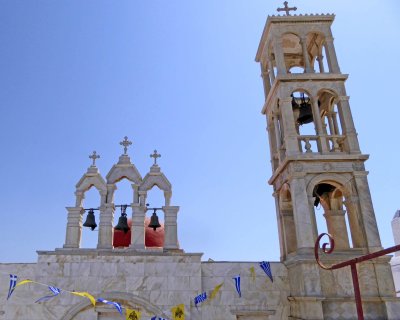
Belltower of the Monastery of Panagia Tourliani |

Four Gospels and Gospel Lectionary, Venice 1803 |

Paper on leather letter of recommendation written in 1758 |

18th Century bier for carrying religious icons during religious processions |

Interesting depiction of the crucifixion in the monastery museum |

Details of the bottom of the cross |
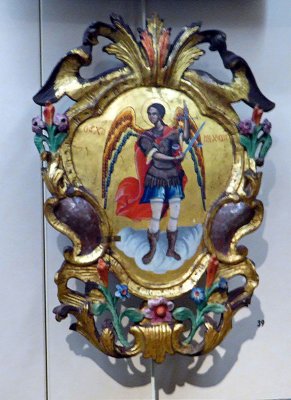
18th century Archangel Michael (egg tempura on wood with gold leaf) |
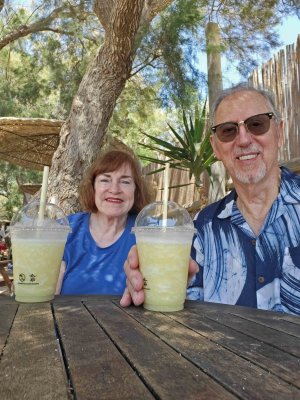
Pina colada break at Agari Beach |

Tsipouro is a grape-distilled spirit (40-45% alcohol) |

Panoramic view of Mykonos Harbor |
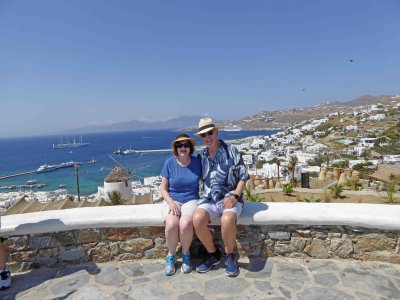
At Mykonos scenic overlook |

Our small group tour of Mykonos |

Watching the Ferries from our balcony |

The Explorer production cast in Devos & Divas |

Hazy morning on the Aegean Sea |

Approaching the island of Santorini, Greece |

Santorini represents the top of a mostly submerged caldera |

Ships anchored off the coast of Santorini |

Vineyards in Santorini are kept low to the ground because of strong winds |

Harvesting grapes in Santorini |

Path from port to one of the towns on Santorini |

Modern houses patterned after windmills on Santorini |
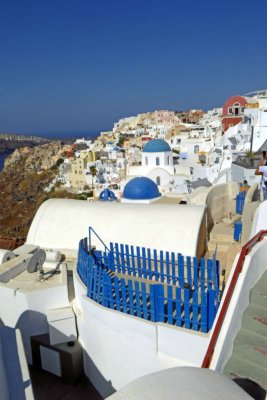
Oia is a pedestrian village on Santorini |

Most photographed view of Oia village |

Another view of Oia |

Bell towers in Oia |

Enjoying the sunshine in Oia |

View of inside of the caldera from Oia |

Blue-domed church in Oia |
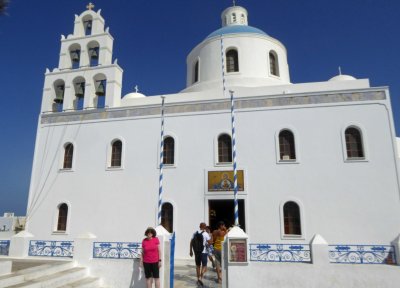
The Church of Panagia Platsani in Oia |
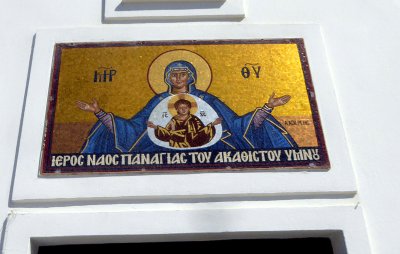
The Virgin Mary overlooks the sea to bless the fishermen of Oia |
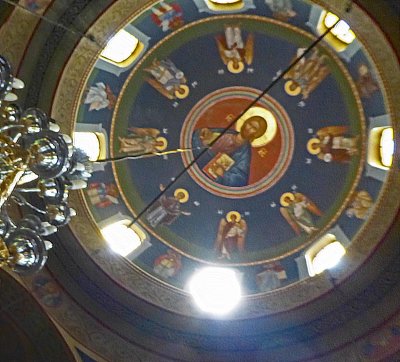
Dome inside the Church of Panagia Platsani |

Pebble mosaic in Oia |

Cow-patterned cat in Oia shoe store |
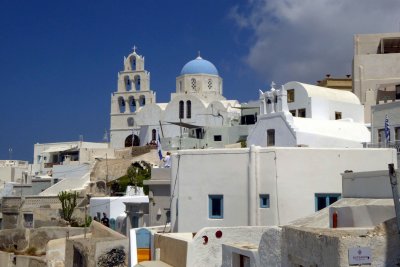
Agia Theodossia Church in the billage of Pyrgos, Santorini |

Agios Nikolaos Church in Pyrgos, Santorini |

There is an abundance of donkeys on Santorini |

Long line for the cable car in Fira, Santorini |

The cable car is the alternative to riding a donkey or walking down 588 steps to the port of Santorini |

People walking down the 588 steps from Fira, Santorini to the port |

Boat in the port of Skala below the town of Fira, Santorini |

Houses on the cliff above the old port of Santorini |

Balancing rocks on the Santorini caldera rim |

Santorini caldera layers were formed between 180,000 and 3,600 years ago |

Enjoying a Bailey's on the balcony after a hot day in Santorini |
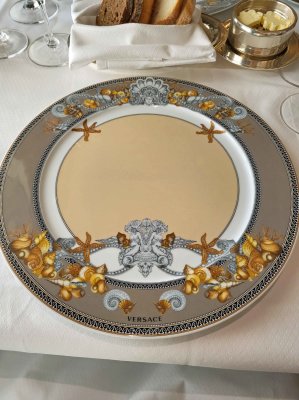
Each restaurant on the ship has unique dinner plates |

Santorini sunset view from our table at dinner |
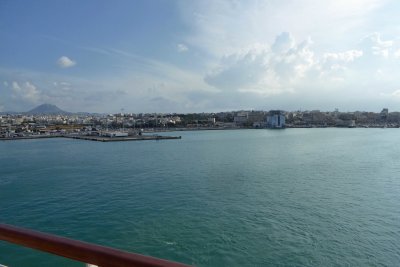
Arriving in Heraklion, Greece on the Island of Crete |

Docked in Heraklion, Greece |

'Castello a Mare' at the old port of Hearaklion was completed in 1540 by the Venetians |

Exploring the countryside of Crete |

Our tour guide caught a locust to show us what was making all the noise |

Entering the St. Irene of Kroussonas Monastery |

Well at the St. Irene Monastery |

St. Irene of Kroussonas Monastery was affluent in the 1600's |

Inside the Monastery of St. Irene of Kroussonas |

Mural of Mary in the Monastery |

Small chapel at the Monastery of St. Irene |

Mosaic outside of chapel at St. Irene Monastery |

Interesting painting of Mary and Jesus |

The Monastery of St. Irene is now a nunnery |

Breakfast for a kitten at the Monastery |
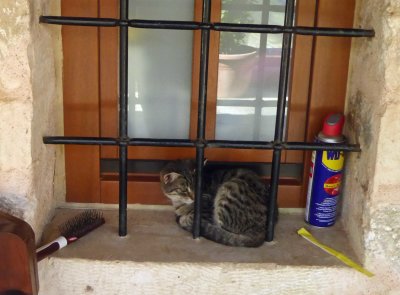
Not sure what to say about this picture at the Monastery |
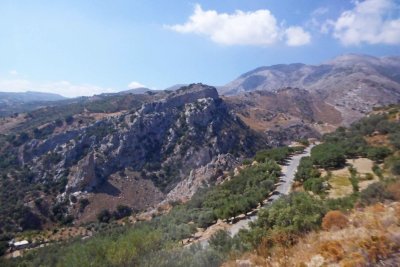
Coming down from the St. Irene of Kroussonas Monastery |

Greek Orthodox Church in the Village of Kroussonas |

Front of Greek Orthodox Church in the Village of Kroussonas |

Bust of Anthony Grigorakis (called Satan) led the resistance against the German occupation of Crete in WWII |

Small Church in Kroussonas, Greece |

Overlooking the village of Kroussonas |
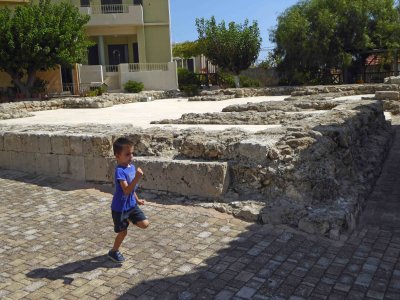
Ruins from WWII bombing in Kroussonas |

Outside Agios Charalambos Church in Kroussonas |

Hole in roof of the church where locals trapped and burned 370 Turkish Albanians during the Cretan revolution |

Inside the restored Agios Charalambos Church |

Fresco of St. George inside the restored Agios Charalambos Church |

Grape arbor in Kroussonas |
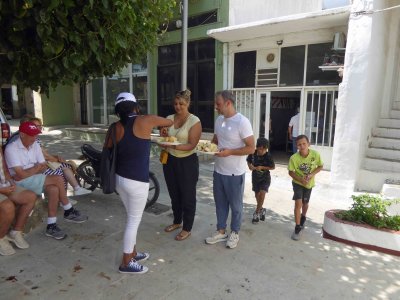
Our two local tour guides serving bread and cheese from shop in the background |
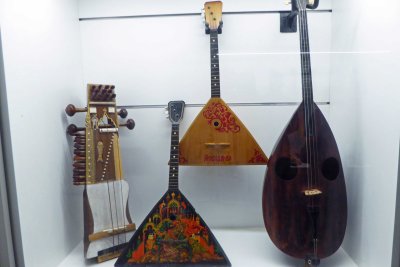
Museum of traditional music instruments in Kroussonas |

Local musician demonstrating traditional instrument |

Susan playing traditional jug instrument |

Stop for lunch at local tavern in Kroussonas |

Our table for lunch |
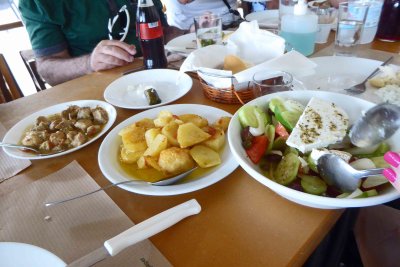
Just a few of the traditional Cretan foods for lunch |

Everyone was betting that the waiter couldn't carry all these dishes |

Waiter carrying all the dishes from our table |

Cretans have been growing olive trees since 3500 BC |

Mount Juktas in Crete is is Zeus head watching at the sky |
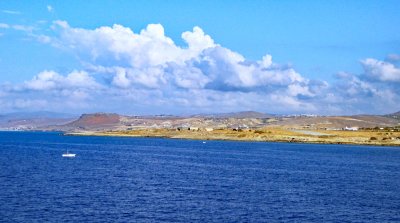
Sailing away from Heraklion, Crete |

Plates at Prime 7 Steakhouse on Regent Seven Seas Explorer |

Huge lobster tail on Surf and Turf |
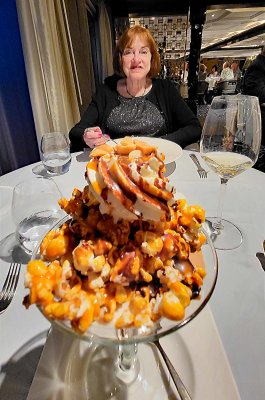
Caramel Popcorn Sundae for dessert |

Can can dancers in 'Paradis' |

Paradis' features Parisian style entertainment |

Exotic costumes in Paradis' |

Red sky morning on the Aegean Sea |

Arriving at the port of Bodrum, Turkey |

Bodrum's 4th Century BC theater was built to hold 13,000 people |

Bodrum's 2,400 amphitheater is still used for concerts |

The seating capacity of Bodrum amphitheater for modern concerts is 10,000 |

Decorations from the 4th Century BC entrance to Bodrum amphitheater |

Cruise ship docked behind the 15th Century Castle of Saint Peter |

Statue of Ataturk, founder of the Republic of Turkey |

Gulets are 2 or 3-masted sailboats built in Bodrum, Turkey |

Gulets in Bodrum are popular for tourists charters |

Bodrum Castle was built as the Castle of Saint Peter by the Knights of Saint John beginning in 1402 |

The walls of the Castle of Saint Peter are studded with 249 coats of arms |

Cat lady in Bodrum, Turkey |

A lot of the stones used in the construction came from the tomb of King Mausolus (353 BC) |

600-year old Ottoman cannons at the Bodrum Castle. Peter |

Coats of arms of the castle commander and Grand Master of the castle |

Altars were used for rituals on family graves around 333-330 BC |

Display of historical anchors -- including stone anchors on display |

The Castle of Saint Peter was taken over by the Islamic Ottoman Empire in 1523 and the chapel was converte |

Inside the Chapel-Mosque of the Castle of Saint Peter |

Remains found inside the Chapel-Mosque of the Castle of Saint Peter |

Entrance to the 'English Tower' in the Castle of Saint Peter |
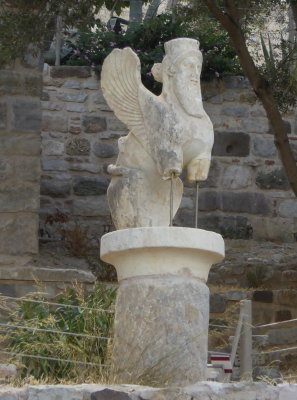
Sphinx statue from 355 BC |
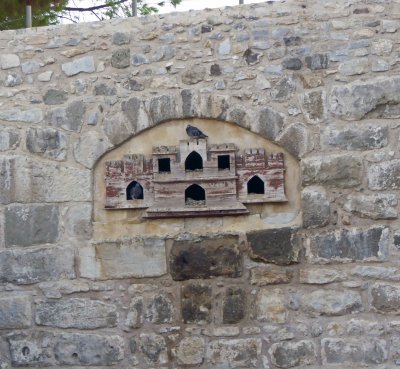
Pigeon house at Bodrum Castle |
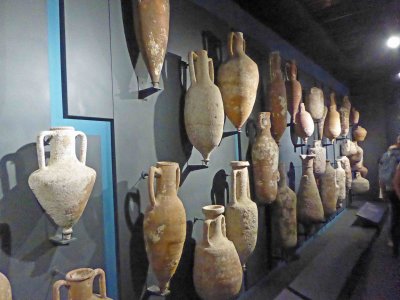
Amphora Jars are part of the Underwater Archaelogy exhibit at Bodrum Castle |
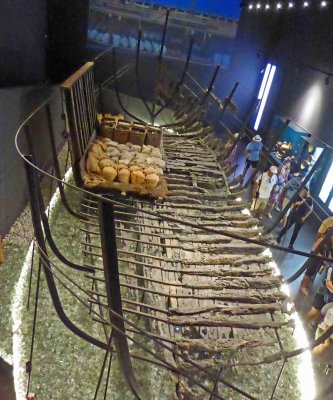
Demonstration of how amphora jars were stored on early cargo ships |

Weapons recovered from shipwreck estimated to be 11th century |

Islamic glass artifacts from Serce Limani shipwreck around 1025 AD |

There was an estimated two tons of raw glass aboard the Serce Limani shipwreck |
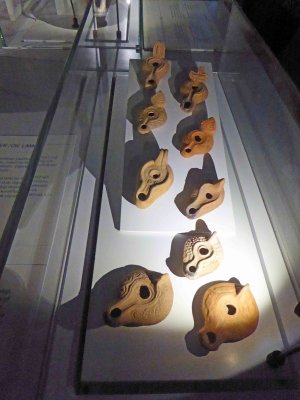
Oil lamps from Yassıada shipwreck (est 7th century AD) |

White Peacock at Bodrum Castle |

Grand Master and Captain of Castle of St. Peter from 1518 |

Artifacts found in the necropolis of Halicarnassus (a 4th century BC Greek city) |

A Kerch style vase found in the necropolis of Halicarnassus (a 4th century BC Greek city) |
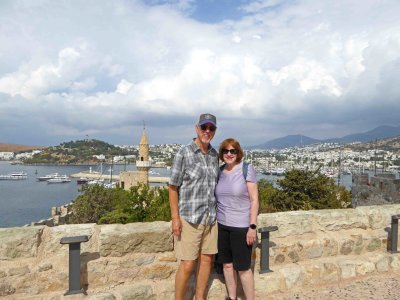
View of Bodrum from the top of the Bodrum Castle |

Panoramic view of the Gulf of Kerme of the Aegean Sea |

The Caarian Princess Exhibit at Bodrum Castle |

Intact skeleton is estimated to have been buried 360-325 BC |

A wax sculpture of the Carian Princess was created using facial recognition technology |

Bronze sword and bone hilt pieces from 12th-11th century BC |

Pair of eyes (5th-4th century BC) found in the Athena Sanctuary |

Description of eyes found in the Athena Sanctuary |

The English Tower, along with French, German, Italian, and Spanish towers housed the Knights of St. John |

Lion from antiquity and coat of arms of Henry IV on the English Tower at Bodrum Castle |

Bodrum castle was under Ottaman rule 1522-1923 |

Topography before the Castle of Saint Peter was built |
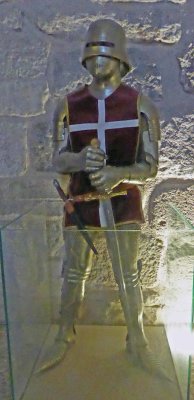
Medieval Knights of St. John uniform. John uniform |

Knight of St. John uniform. John uniform |

Coats of arms of each the seven ethno-linguistic divisions of the Knights of St. John |

The Spanish Tower sits behind artifacts from various periods of antiquity |

The Spanish Tower is also known as the Snake Tower |

The German Tower sits at the opposite end of the plaza from the Spanish Tower |
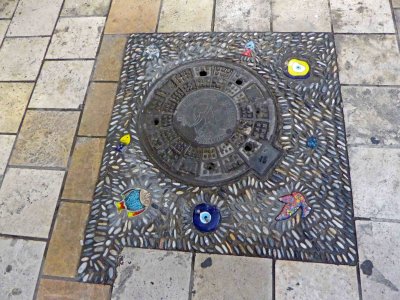
Manhole cover in Bodrum decorated with the 'evil eye' to ward off evil |

Turkish sweet shop |
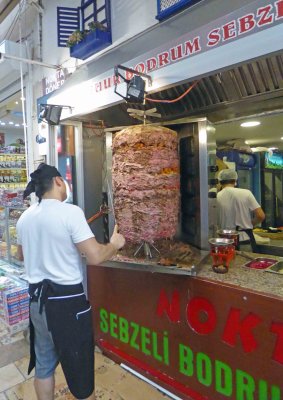
Turkish street food |

Lunch at Turkish market |
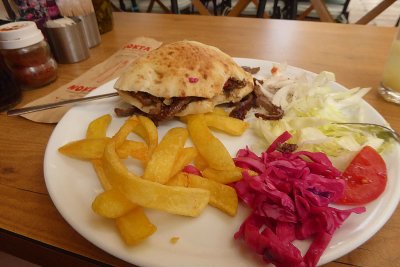
Tombik is a Turkish sandwich stuffed with meat |

Adliye Mosque (1902) is adjacent to the main square in Bodrum, Turkey |

Watching what I assume is a sailing school in Bodrum Bay |

Sailing out of Bodrum, Turkey |

Looking at Bodrum Castle as we sail away |

Plates in Chartreuse French restaurant on Regent Seven Seas Explorer |
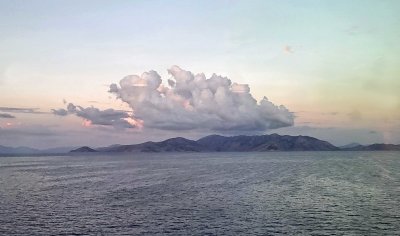
View from Chartreuse at dinner |
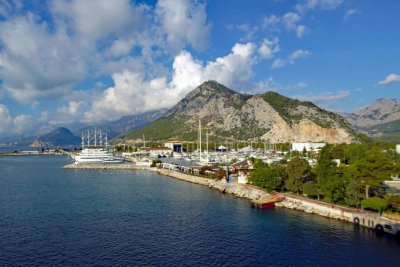
Sailing into Antalya, Turkey |

Statue in Antalya, Turkey |

Hadrian's Gate is triumphal arch in Antalya, Turkey |

Hadrian's Gate was built in130 AD to commemorate Roman Emperor Hadrian’s visit to Attaleia (now Antalya) |

Ruts in the marble in Hadrian's Gate from chariots |

Archway is decorated with floral and rosette reliefs |

Lion's heads on the cornice are believed to separate what was a second floor on Hadrian's Gate |

Old Town Antalya |
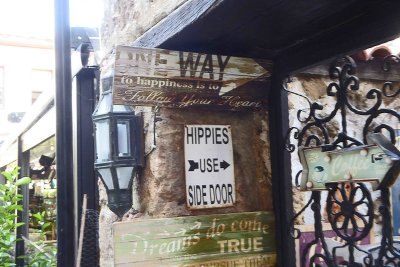
Signs in Old Town Antalya |

Turkish pretzel vendor |

Kesik Minaret (1361 AD) in Old Town Antalya |
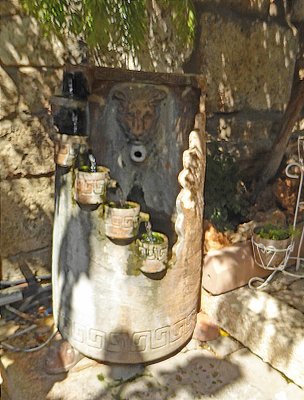
Ancient fountain in Anatalya, Turkey |

Old city marina in Antalya |

Long walk to the restroom at bar in Antalya |

Street in Old Town Antalya |

The Fluted Minaret of Antalya, first built in 1230, was reconstructed in 1373 |

The National Ascension Monument in Republic Square, Antalya |

Entering the Antalya Archaeological Museum |

Clay jar burial was practiced as early as 4500 BC and as recent as the 17th Century |

Example of remains found inside burial jar |

Pottery from 9th-7th Century BC |

Pottery from 5th-4th Century BC |

Limestone relief from 490-479 BC |

One of the rooms in the Antalya Archaeological Museum |

Emperor Hadrian Statue (2nd Century BC) |

Aphrodite (goddess of sexual love & beauty) Statue (2nd Century AD) |

Athena (goddess of battle strategy & wisdom) statue (2nd Century AD) |

Zeus (chief Greek diety) statue (2nd Century AD) |
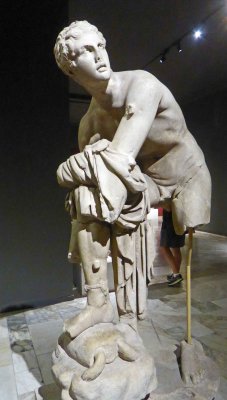
Hermes (god of speed) statue (2nd Century AD) |
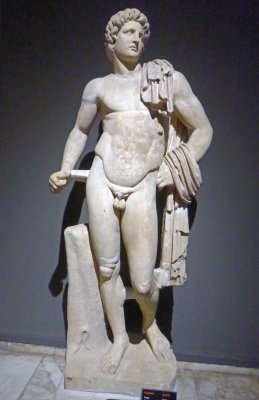
Apollo (god of music, poetry, & dance) statue (2nd Century AD) |

Hecate (goddess presiding over magic and spells) statue (3rd Century AD) |

Interesting sculpture at the Antalya Archaeological Museum |

Really big statue of Hermes (2nd Century) |
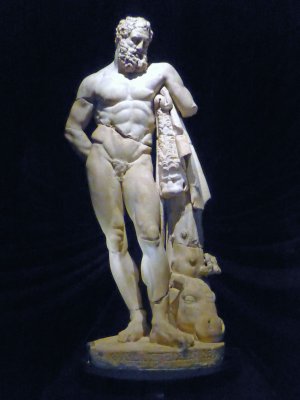
Hercules (god of strength) statue (2nd Century AD) |

Scene of Sacrifice frieze (2nd Century AD) |

The Hercules Sarcophagus (2nd Century AD) |

Sarcophagus of Aurelia Botiane & Demetria (2nd Centruy AD) |

Roman Sarcophagus lid with Lion |

Bill with large burial jar |

Plate from Pacific Rim Pan-Asian restaurant on RSSC Explorer |

Fried Lobster appetizer |

View of Rhodes, Greece from our balcony |

The defensive walls around the city of Rhodes date to the 4th Century BC |

Two identical houses in Rhodes built as a dowry for two daughters in accordance with tradition |

Lindos is said to be founded by the Doriansa around the 10th Century BC |

Belltower of the Church of Panagia (1300 AD) |

Pebble Mosaic in Lindos, Rhodes, Greece |

Looking down on the village of Lindos |

An ancient triimolia (a kind of ship) carved in the rock circa 180-170 BC at the Lindos Acropolis |

Steps leading to the 14th Century fortress built by the Knights of St. John |

The Castle of the Knights of St. John was built on the remains of Byzantine fortifications |

Our tour guide shows what the Temple of Athena would have looked like in the 4th Century BC |

Susan waiting in the shade rather than taking the rocky trail to the top |

People on the rocky climb to the Temple of Athena at the Lindos Acropolis |

Remains of the Temple of Athena Lindia from 4th Century BC |

At the Temple of Athena Lindia above St. Paul's Bay on Rhodes |

Cliffs in the background were used in the 1961 'Guns of Navarrone' |

Remains of the 13th or 14th Century Church of St. John on the Acropolis of Lindos |

Staircase of the Propylaea (gateway) to the Temple of Athena Lindia |

A semicircular exedra of the priest Pasiphon (2nd Century BC) |

The steep steps built in the 14th Century by the Knights of St. John |

Last look at the Acropolis of Lindos |

Ottoman influence in the city of Rhodes |
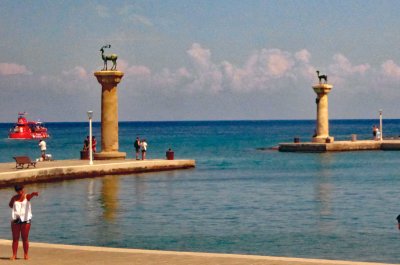
Columns at entranve to Mandraki Harbor's stand where the legendary Colossus of Rhodes stood in 280 BC |
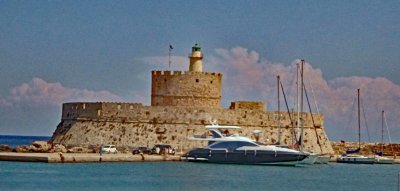
The Fort of Saint Nicholas was build between 1464 and 1467 by the Knights of St. John |

Eli Beach boardwalk in Rhodes |
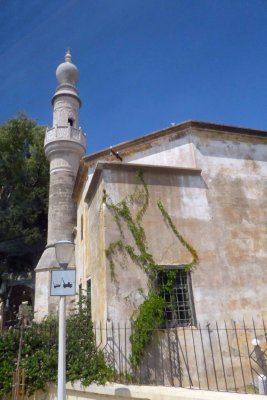
Mosque of Murat Reis (1524) in Rhodes Town |

Coat of Arms of Grand-Master Emery d'Amboise above the Amboise Gate |
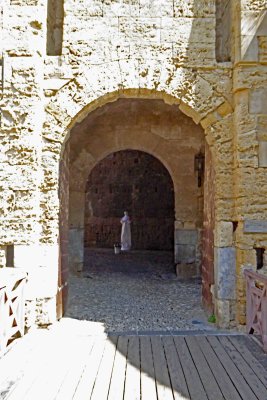
Entering the Gate d’Amboise in the Palace of the Grand Masters in Rhodes |

Italy took control of Rhodes in 1912 and began restoration of the castle in 1930 |

The History Palace in Rhodes dates back to the end of the Byzantine period |

Cat walks and ramparts along the top of the city walls were used by sentries |

The courtyard of the palace contains statues of Roman Emporers from the Hellenistic period (323 BC - 33 BC) |

Mosaic floor moved from the island of Kos, Greece dates to 3rd Century AD |

Trophy from the cemetery in the ancient city of Rhodes (1st Century BC) |

During restoration, Hellenistic, Roman, and Early Christian mosaics were taken from the island of Kos to rebuild the floors |
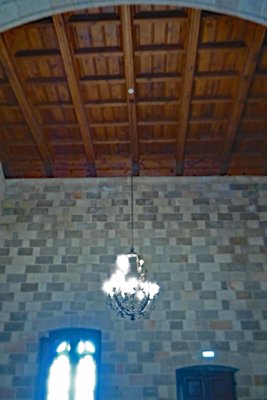
Ceiling in the Palace of the Grand Masters in Rhodes |

Mosaic of Medusa (3rd Century AD) from the island of Kos |

Vaulted ceiling in the Palace of the Grand Masters |

The Palace of the Grand Master was used as a holdiay residence for King Victor Emmanuel III of Italy |

Mosaic floor in the Palace of the Grand Master |

Venetian glass chandelier in the Palace of the Grand Master |

Fascist dictator Benito Mussolini occupied and carried out extensive renovations on the Palace of Grand Master |

Angel Gabriel and Virgin Mary |

Street of the Knights in Rhodes is one of the best preserved Medieval streets in Europe |

There were 7 inns (palatial residences) on the Street of Knights from each country of the Knights of St. John |

The Inn of France is the most ornate of all the inns with crocodile gargoyles adorning the roof |
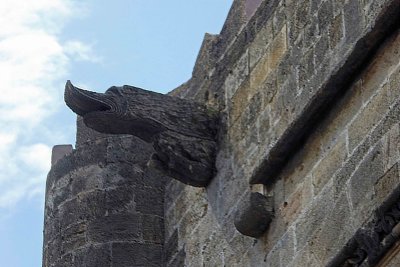
The crocodile gargoyle was supposedly to honor the Grand Master for killing a crocodile that terrified the city of Rhodes |

The German inn on the Street of Knights |

The Archaeological Museum of Rhodes is in the former Hospital of the Order of the Knights of St John |

Old catapult stone ball projectiles |

One of the areas used as a hospital by the Knights of St. John |

Coat of Arms of Crispi next to an angry-looking lion of St Mark |

Head of Kouros found in Camirus (6th Century BC) |
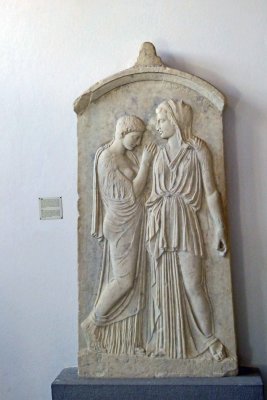
Marble funerary stele of Krito (daughter) and Timarista (mother) from 420-410 BC |
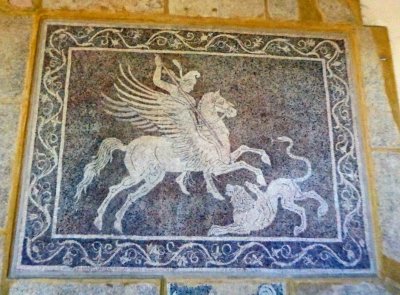
Pebble mosaic shows mythical hero Bellerophon on his winged horse Pegasos preparing to strike the Chimaira |

White & grey pebble mosaic shows a Centaur with a hare he killed with his sling |

Docked in Kusadasi, Turkey |

Our view of the Byzantine Fortress of Kusadasi |

Hand of Peace sculpture in Kusadasi, Turkey |

The House of the Virgin Mary is located on Mt. Koressos in Turkey\ |

It is believed that Mary was taken to this stone house by Saint John and lived there for the remainder of her earthly life |

The shrine has been visited by several Popes -- including Paul VI, John Paul II, and Benedict XVI |

Mary & Jesus are mentioned in the Koran |

'Wishing Wall' where pilgrims tie their personal intentions on paper or fabric |

Ephesus was built in the 10th century BC and was the 2nd most important city in Asia in the 5th and 6th centuries |

Odeum Theater in Ephesus was commissioned around 150 AD and served as a city council chamber |

The Prytaneion of Ephesus is where religious ceremonies, official receptions, and banquets were held (3rd Century BC) |

Memmius Monument in Ephesus was built in the 1st century AD by Augustus |

Susan with the Greek Symbol of Medicine in Ephesus, Turkey |

The Hercules Gate served to halt horse and chariot traffic in the 4th century forcing visitors to walk from here |

Legend says that people who are able to touch both sides of the Hercules Gate will gain great strength |

The marble relief of the Greek goddess of victory Nike (1st - 2nd century AD) decorated the arch over Hercules Gate |

Crowds on Curetes Street in Ephesus in 2022 |

Curetes Street in Ephesus when we visited Ephesus in 1998 |

Nymphaeum Traiani (102-114 AD) in Ephesus was built as a fountain to honor the goddess Artemis and Emperor Trajan |

Terrace Houses of Ephesus consist of six 1st Century BC luxury Roman Villas |

Mosaic street in front of Terrace Houses (also known as Houses of the Rich) in Ephesus |

The Temple of Hadrian was built before 138 A.D and was dedicated to the Roman Emperor Hadrian |

The free public latrine in Ephesus had fresh water flowing underneath and in the channel in front for cleaning |

Public Toilet in Ephesus wasn't roped off in 1998 |
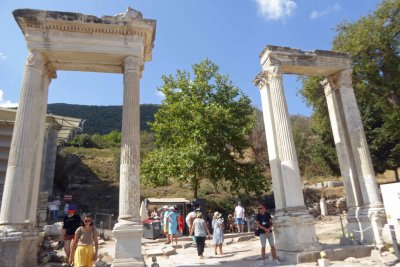
Hadrian’s Gate is a triumphal arch in Ephesesus where the Queen of Sheba passed on her way to visit King Solomon |
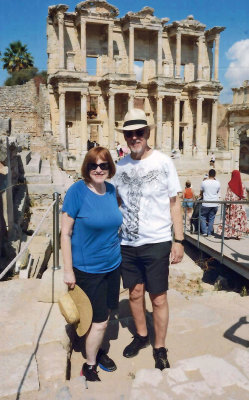
The Library of Celsus (117 AD) was a repository of over 12,000 scrolls |
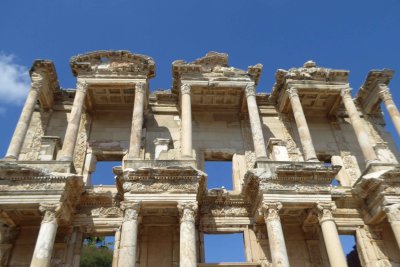
The Library of Celsus was important to Christianity since Christianity placed great emphasis on the written word |
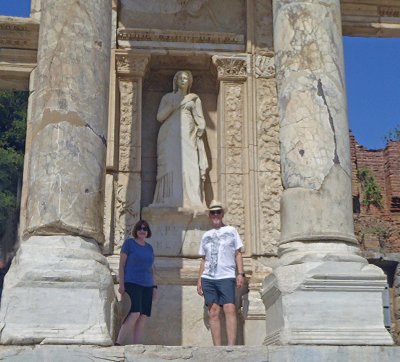
Four statues adorn the Library of Celsus representing Sophia (Wisdom), Arete (Bravery), Episteme (Knowledge) and Ennoia (Thought |

Celsus, Governor of the Roman province of Asia in 115 AD, is buried in a sarcophagus beneath the library |

The Mercantile Agora of Ephesus was entered by the 1st Century AD Gate of Mazeus and Mithradates |

A boy found a dog under the Gate of Mazeus and Mithradates |

The Commercial Agora of Ephesus was surrounded by colonnaded porticoes |

Beside the Agora of Ephesus were a series of shops with some dating to the 8th Century BC |
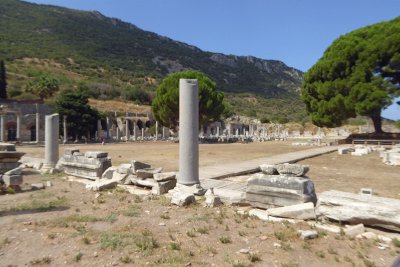
St. Paul worked in the Ephesus Agora with Priscilla and Aquila in their tentmaking and leatherworking business |

'Roman Soldier' on a hil overlooking the Ephesus Agora |

The Great Theater in Ephesus (250 BC) has a capacity of 25,000 seats |

The Apostle Paul delivered a sermon condemning pagan worship in this theater |

Fruit table at lunch |

A sarcophagus outside the Ephesus Archeological Museum |

Coins that were used from 27 BC to 268 AD |
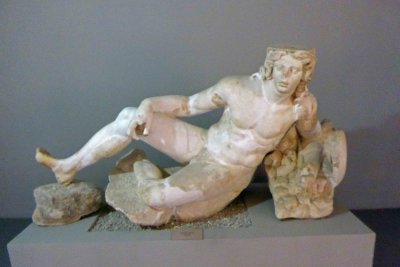
Resting Warrior (69 AD) |

Marble Sarcophagos with Eros (3rd Century AD) |

Late Roman Gladiator Relief |

Marble Griffin Statue (3rd Century BC) |

Marble Griffin Head (3rd Century BC) |

Anatolian Mother Goddess (5,750 BC) |
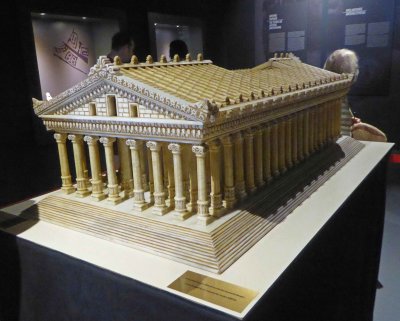
Model of the Temple of Artemis which was one of the 7 Wonders of the Ancient World |

Statue of Artemis inside the model of the temple |

Bronze Griffin Head (8th-7th Century BC) |

Artemis Statue (1st Century AD) |
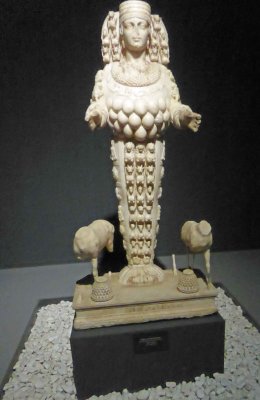
Artemis Statue (2nd Centruy AD) |

Head and Arm of Roman Emperor Domitian (reigned 81-96 AD) |

The Palm Wings Ephesus Beach Resort & Spa is just one of many Kusadasi resorts on the Aegean Sea |

The Kusadasi Downtown Beach |
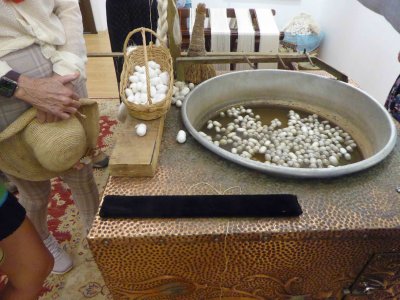
Demonstration on extracting silk from the cocoons |

This catches the silk to extract from the cocoon |

Handmade carpet using pattern of the oldest carpet in the world (5th Century BC) |

Ataturk statue overlooking Kusadasi, Turkey |

Sailing past the Alkoclar Adakule Hotel Kusadasi |

Back at Prime 7 Steakhouse for an 18-oz bone-in ribeye |

Regent Seven Seas Explorer at anchor offshore from Dikili, Turkey with sky & water the same color |
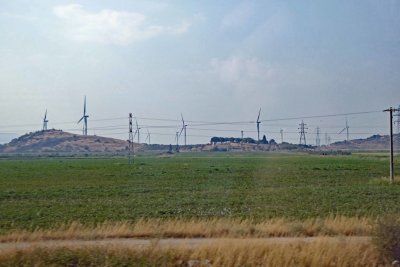
Wind farm outside of Dikili, Turkey |

Interesting Mosque in Bergama, Turkey |

Cows grazing outside the entrance to the ruins of Pergamon |

Entering the Pergamon Asklepion which was an important health treatment and curing center from 4th Century BC to 2nd Centruy AD |

The Pergamon Asklepion was the lower part of a 220 acre city |

Truncated column with the two snake symbols of Asclepius, Greek god of healing |

Asclepius association of snakes with medicine is still seen in medical symbols today |

People came here for long term stays to get rehabilitated, so entertainment was provided in this theater |

Askeplion Theater could hold 3500 people |

Steps in the theater were decorated with Griffin feet |

A tortoise at the Pergamon Asklepion |

People were purified in this sacred fountain before treatment (still flowing 2500 years later) |

Underground passage leads to the Healing Center of Asceplion |

Water flowed down the stairs and through the tunnel for use in the healing center |

Tunnel to the Aceplion Healing Center |

These clay pipes in the ceiling of the healing center are thought to provide showers for patients |

Back above ground in the Pergamon Asceplion |
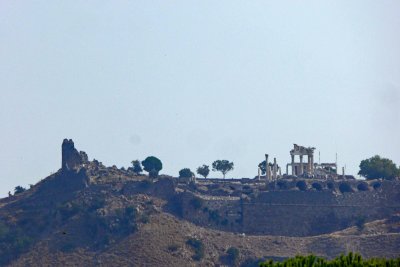
View of the Pergamon Acropolis from the Asceplion below |

Cable cars to the top of the Pergamon Acropolis |

Pergamon was founded in the 3rd century BC as the capital of the Attalid dynasty |

Overlooking the city of Bergama, Turkey (sits on top of ancient city of Pergamon) |

The sanctuary of the Temple of Trajan was built in the 2nd century AD and supported by a row of eleven arched tunnels |

The Pergamon Theater (built in the 3rd BC) held 10,000 people and was the steepest in the ancient world |

Susan in the shade or the Temple of Trajan (Trajaneum) at Pergamon |

The Temple of Trajan at Pergamon was built around 114 BC |

Inside the Temple of Trajan at Pergamon |

View of the Kestel Dam below Pergamon from the cable car |

Returning to the ship on a tender boat |

Attending the Regent Seven Seas 30th Anniversary Celebration |

RSSC Explorer Cruise Director and entertainment staff |
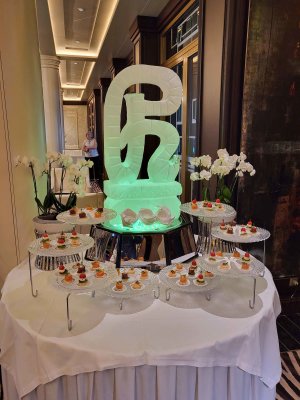
Ice Sculpture and canapes |

David, Susan, and Barbara |

Three entertainers who will be on Voyager with us next year |

Susan, Bill, Jill, Paul, Ann, & Bill |

Hazy morning in Istanbul |

View of Istanbul and the Blue Mosque from our balcony on the RSSC Explorer |

View of Galata Tower & Hagia Sophia Mosque in Istanbul |
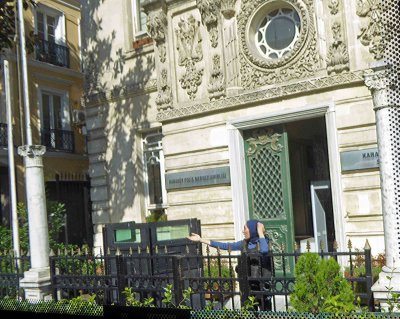
Muslim policewoman in Istanbul |

Viewing the European side of Istanbul from the ferry |

'New Valide Sultan Mosque' (1665) in Istanbul |

Ships docked in Istanbul, Turkey |

Gull following the ferry on the Bosphorus Strait |
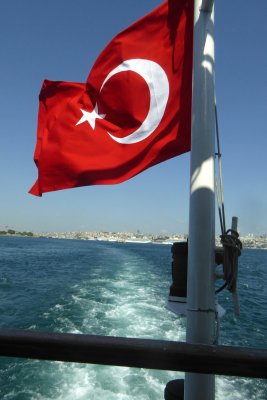
Turkish flag flying on the back of the ferry in Istanbul |

The European side of Istanbul from the rear deck of the ferry |

Selimiye Barracks (1828) is where Florence Nightingale served 1854-57 |

Waiting toride the nostalgic tram through the Asian side of Istanbul |

The Kadıkoy Carsısı market is realistic depiction of the Asian side of Istanbul |

Tripe, pig knuckle, and calf head for sale at Kadıkoy Carsısı market |

Having lunch at a restaurant on the Asian side of Istanbul |

Some of the dishes for lunch in Asian Istabul |

Turkish desserts at Yanyali Restaurant |

The Asian side of Istanbul is primarily residential and shopping |

Susan found a new hat on the Asian side of Istanbul |

Donut vendor on the Asian side of Istanbul |

Bavarian Cream-filled Donut in Istanbul |

Saloon Burger is a Turkish chain with over 35 locations in Istanbul |

Street of shoe vendors in Asian Istanbul (mostly knock-offs of American brands) |

'Lokma' is fried dough soaked in sugar syrup or honey |
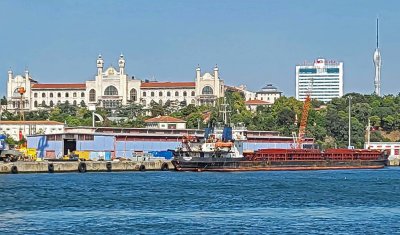
Imperial College of Medicine of Marmara University in Istanbul |

Message above the Blue Mosque at night |

Hagia Sophia Grand Mosque in Istanbul |

The German Fountain sits at the north end of the old hippodrome in Istanbul |

The German Fountain was constructed to commemorate the 2nd anniversary of German Emperor Wilhelm II's visit to Istanbul in 1898 |

Two obelisks stand at the south end of the old hippodrome of Athens |

The Obelisk of Theodosius and Obelisk of Constantine in Sultanahmet Square, Istanbul |

The Obelisk of Theodosius was erected in 1500 BC and stood at the Karnak Temple in Egypt before being brought to Istanbul in 390 |

Dinner in the Kumkapi District of Istanbul on the Marmara Sea |
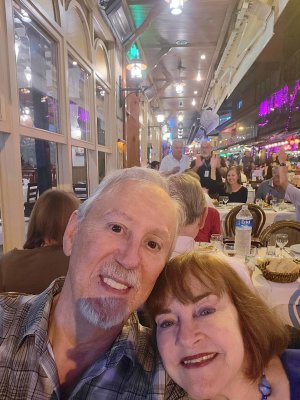
Dinner at CaPaRi Seafood Restaurant in Istanbul |

This is the same man in the poster behind him selling 'Dondurma' (elastic Turkish ice cream) |

'Dondurma' is ice cream made with a tree resin and the roots of wild mountain orchids which adds elasticity |

Bill just wanted to try 'dondurma' but ended up as part of a show |

Yavuz Sultan Selim Bridge viewed from the Galata Bridge in Istanbul |

October 29th is Republic Day in Turkey |

Dolmabahce Palace was the home of the Ottoman Empire from 1856 to 1887 and from 1909 to 1922 |

Dolmabahce Palace was built between 1843 and 1856 |

Over 14 tons of gold were used to gild the ceilings in Dolmabahce Palace |

Bedroom of Sultan Abdulaziz in Dolmabahce Palace |

Reception hall in Dolmabahce Palace |

Sultan's Hamam (Turkish bath) is decorated with Egyptian alabaster |
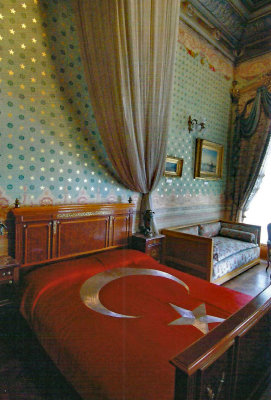
Mustafa Kemal Atatürk spent the last days of his life in Dolmabahce Palace and died in this room in 1938 |

Statue in the garden of Dolmabahce Palace |

Guinea Hens in the garden of Dolmabahce Palace |

Fountain in the garden of Dolmabahce Palace |

Lots of cats in Turkey -- including on the grounds of Dolmabahce Palace |

Gardens of Dolmabahce Palace |

Gate of the Sultan in Dolmabache Palace |

Dolmabache Clock Tower near the Gate of the Treasury |

Entering the Grand Bazaar in Istanbul |

The Grand Bazaar in Istanbul is one of the largest and oldest covered markets in the world |

The Grand Bazaar has 61 covered streets and over 4,000 shops |

The origins of the Grand Bazaar in Istanbul date to the 15th Century AD |

Daytime visit to the Obelisk of Theodosius |

Marble pedestal under the Obelisk of Theodosius has reliefs dating to the time of the obelisk's re-erection in Constantinople |

The Blue Mosque in Istanbul is officially the Sultan Ahmed Mosque |

The Hagia Sophia Grand Mosque was originally an Orthodox 'Church of the Holy Wisdom' |

Entering the Hagia Sophia Grand Mosque |
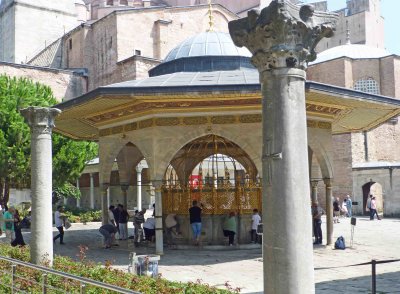
Muslims perform cleansing at this fountain built in 1740 by Sultan Mahmut I before entering Hagia Sophia Grand Mosque |

Susan had to wear Bill's hat to meet requirements for women to have heads covered at Hagia Sophia Grand Mosque |

The Hagia Sophia was the religious and spiritual centre of the Eastern Orthodox Church for nearly one thousand years |

The Hagia Sophia was built as the Christian Cathedral of Constantinople between 532 and 537 |

The dome in Hagia Sophia has 40 windows surrounding it |

Hagia Sophia was a mosque from 1453-1935, then a museum, and reverted back to a mosque in 2018 |
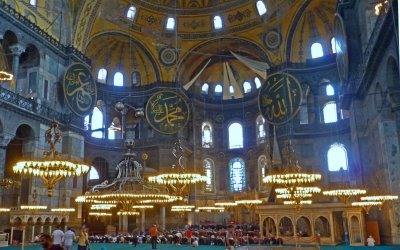
Hagia Sophia Grand Mosque allows visitors; even during the Muslim call to prayer |
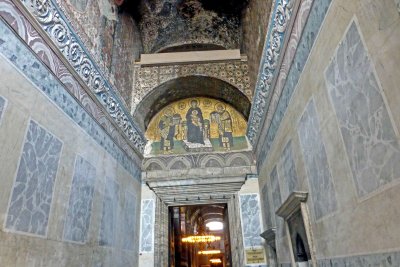
Mosaic in the southwest vestibule of Hagia Sophia |

The Fountain of Sultan Ahmed III (built in 1728) stands behind the Hagia Sophia in Istanbul |

The Fountain of Ahmed III sits in the great square in front of the Imperial Gate of Topkapı Palace in Istanbul |

The Fountain of Ahmed III provided free drinking water to residents of Constantinople |

Hotel Valide Sultan is only steps away from Topkapi Palace and the Hagia Sophia in Istanbul |

Old city walls of Istanbul were built in the 4th-5th Centuries AD |

Structure in Istanbul built around 1453 as a bathhouse is now used as a warehouse |

Galata tower was built in 1348 and is one of the oldest towers in the world |

The Spice Bazaar (also called Egyptian Bazaar) was built in 1664 |
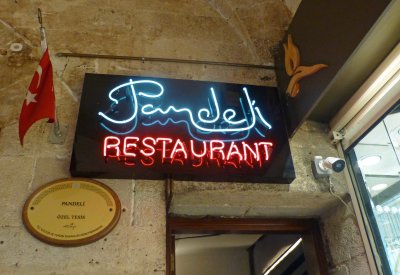
Pandeli is a restaurant in the Egyptian Bazaar that has been in business for over 100 years |
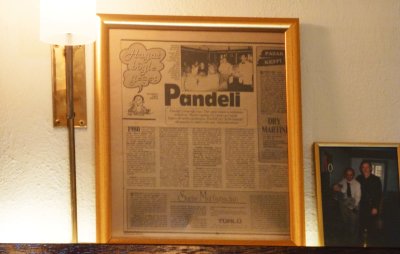
Pandeli has hosted celebrities, including Queen Elizabeth II, Audrey Hepburn, Sean Connery, and Robert de Niro |

Pandeli Restaurant is known for its colorful tile work |

Crowds of shoppers on Republic Day (a holiday to celebrate Turkish independence) |
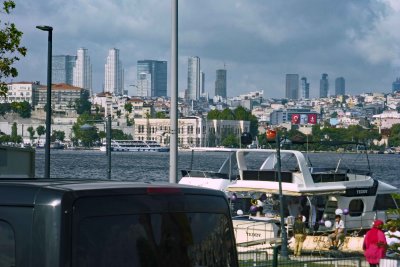
Skyline of Maslak, the main business district of Istanbul |

Istanbul Airport opened in 2018 |

Istanbul Airport bills itself as a 'Child and Family Friendly Airport' |

Istanbul Airport offer a free tour using the 'İGA Children's Train' |

At the Istanbul Airport |

Leaving Istanbul |

Arriving at Nevsehir, Turkey Airport |

First look at our room in the Utopia Cave Hotel |

Rooms are designed to give the feeling of sleeping in a cave |

Antique telephone is still functional |

Arriving at launch site for our hot air balloon over Cappadocia, Turkey |

First hot air balloons are in the air over Cappadocia |
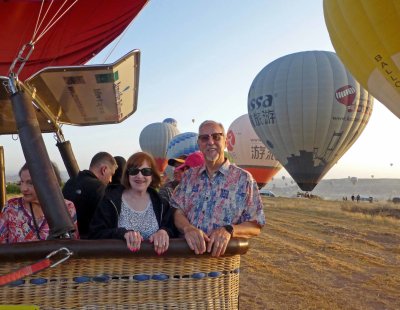
In the hot air basket waiting to launch |

Cappadocia’s landscape developed 60 million years ago as a result of volcanic activity and erosion |

100-150 balloons fly over Cappadocia daily (weather permitting) |
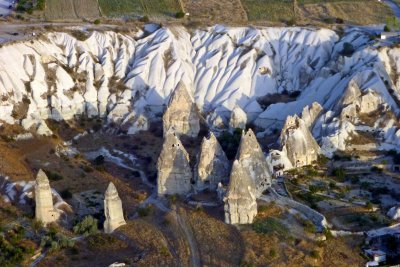
Cappadocia landscape includes towers, cones, valleys, and caves formed by water and wind erosion |

Towns in Cappadocia co-exist with cones previously used as shelter by people as early as 4th Century BC |

Aboard our hot air balloon |

Flying over agriculture in Cappadocia |

Rock formations in Cappadocia are often called 'fairy chimneys' |

Cappadocia residences were dug out of the soft volcanic rock |
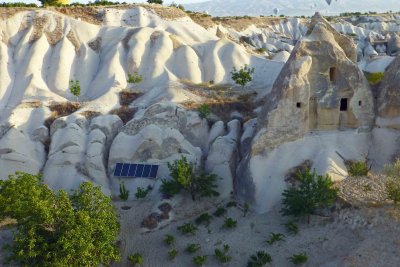
The Turkish government banned living in fairy chimneys, but this solar panel would suggest otherwise |

The dogs on this property would also support my feeling that the fairy chimney is occupied |

The top of a hot air balloon peeks up from its descent into a canyon |

Our hot air balloon descending into a canyon in Cappadocia |

Flying down a canyon in Cappadocia |
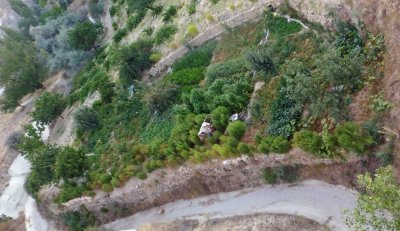
Farming in a canyon in Cappadocia |

At 8 AM from deep in a canyon it looks like sunrise |

Rising out of a Cappadocia canyon |

Colors of rock make this look like a scene from the Arctic |

Flying over a pumpkin field in Cappadocia |

Uchisar (means Outer Citadel) is a village in Cappadocia, Turkey |

It's hard to fully appreciate the Cappadocian landscape on the ground |

Large mosaic on the ground near a balloon landing zone |

Legend says that Cappodocia comes from the Hittite word 'Katpatuka' which means 'Land of Beautiful Horses' |

Farms in Cappadocia |
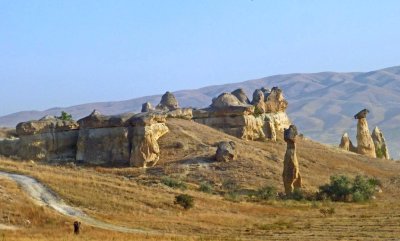
Soft volcanic rock (tuff) topped with harder basalt which erodes more slowly |

Different speeds of erosion creates interesting rock formations |

Coming in for a landing in Cappadocia |

The pilot set the basket down on this trailer |

The tradtional post-flight champagne toast (our pilot on the right) |

Another Hot Air Balloon Certificate for our collection |

Back at the Utopia Cave Hotel |

Relaxing outside our room at Utopia Cave Hotel |

Bridge from our room to the hotel restaurant |

Utopia Cave Hotel Restaurant is visible from our room |

Wall of wine bottles at entrance to restaurant |

Visiting Kaymakli Underground City (built around 8th-7th Centuries BC) |

Feeding troughs for animals kept on the top floor of Kaymakli Underground City |

The city was greatly expanded and deepened 780-1180 AD |

Small chapel built by Christian inhabitants who occupied the city from the 4th to the 14th Centuries AD |
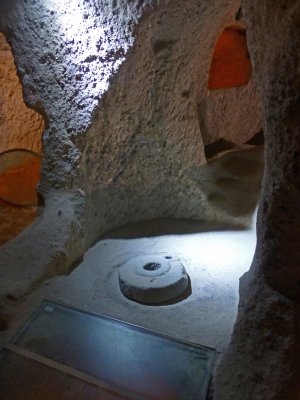
Millstone in Kaymakli Underground City |
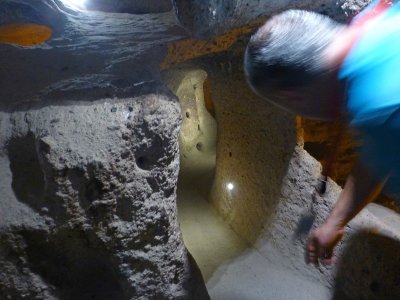
The tunnels of Kaymakli are lower, narrower, and more steeply inclined than other underground cities in the Cappadocia region |
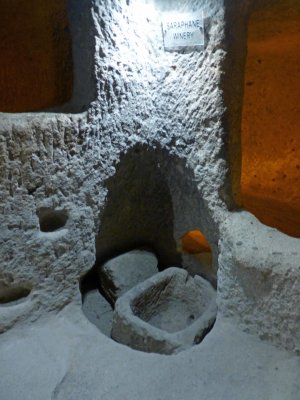
One of several wineries found in Kaymakli Underground City |
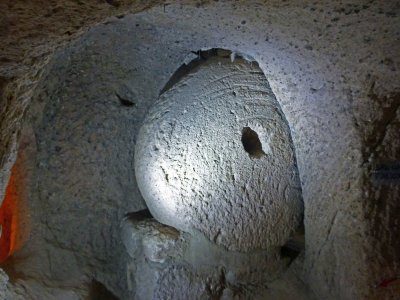
Huge stones were rolled across doorways to protect against invaders |

One of the ventilation shafts in Kaymakli Underground City |

Kaymakli has a total of 8 floors as deep as 12.5 miles |

Storage rooms and areas for earthenware jars on the fourth floor indicates some economic stability in Kaymakli |
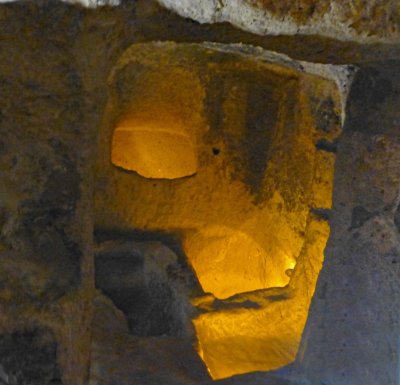
A kitchen in Kaymakli Underground City which housed as many as 5,000 people at one time |
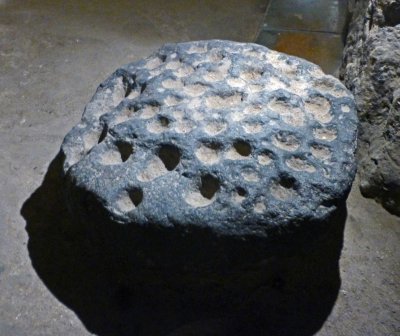
Block formation of andesite (a volcanic rock) with several holes (used in Kaymakli for cold copper processing) |

Bill was almost too tall to visit Kaymakli Underground City without crawling on hands and knees |

Underground caves (with a constant temperature 55.4 degrees) are now used to store fruit and vegetables awaiting export |

Woman weaving rug using Turkish double knots |

Hand-woven Turkish rug that looks like a Thomas Kinkade painting |

Lunch at Areni Cappadocia in Urgup, Turkey |

There are always lots of Mezes (appetizers) in Turkey |

'Testi Kebab' is a regional specialty where meat and spices are cooked in a sealed clay pot for about 3 hours |

Cappadocia roundabout honoring 'the land of beautiful horses' |

This 6-7 story rock mass is known as the 'Nunnery' and contains dining hall, kitchen, ruined chapel, and some living quarters |

The Goreme churches contain many frescoes, but photography is not allowed |

The Goreme Open Air Museum contains 15 rock-cut churches and 11 refectories from the 10th - 12th Centuries AD |

Dark Church (Karanlık Kilise) dating to the mid-11th Century AD |

It was hot and we were tired so I zoomed the exterior of the Dark Church |
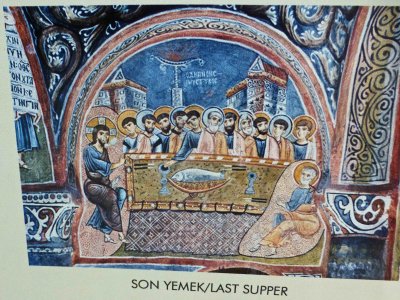
The Last Supper is a frescoe that is found in the Dark Church |

Entrance to the Maltese Cross Church in Goreme Open Air Museum |

The Snake Church in Goreme Open Air Museum |

Fresco in the Snake Church at Goreme Open Air Museum |

St. Barbara's Chapel in Goreme Open Air Museum |

Nave & Apse in St. Barbara's Chapel. Barbara's Chapel |

Fresco in St. Barbara's Chapel depicts the devil defeated by crosses in his attempt to convince monks to abandon their monastic |

Tokali (buckle) Church is the oldest rock-cut church in the region (9th Century) |

Tokli Church interior has been under restoration since 1970 |
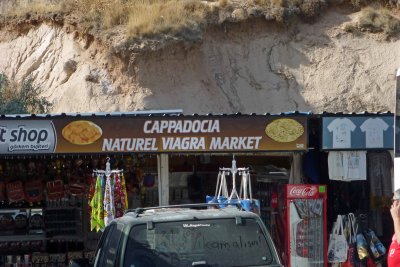
I'm not sure this is the photo stop our guide had in mind |

Devrent Valley is also called as 'Imagination Valley' |

Camel rock in Devrent Valley in Cappadocia |
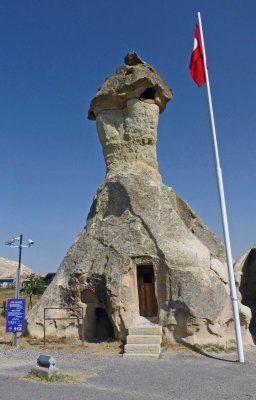
Pasabagi Valley Police Station is housed in a Fairy Chimney |

Walking through Pasabagi Valley |

Pasabagi Valley is famous for its wonderful lanscape and the best collection of fairy chimneys in Cappadocia |

Interesting rock formation in Pasabagi Valley |

Rock formation in Pasabagi Valley looks like something out of a Tolkein novel |

St. Simeon lived in the top of this hollowed out chimney (5th C) & only descended for food and drink delivered by his disciples |

This dog joined our group and stayed until the end of the walk |

Avanos, Turkey is famous for its pottery which has been made here since the time of the Hittites (2000 BC) |

House in Avanos, Turkey decorated with pottery |

Watching a potter using a kick wheel in Avanos, Turkey |

Traditionally in Cappadocia, a boy couldn’t get married if he didn’t know how to make a clay pot |

Pottery at Omurlu Ceramics has been produced here since 1807 |
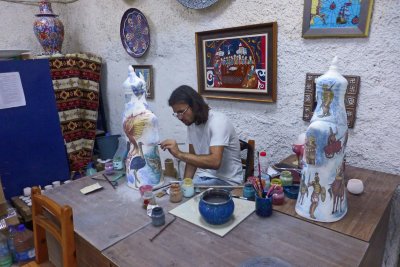
Hand-painting pottery at Omurlu Ceramics |

Detailed painting of pottery at Omurlu Ceramics |
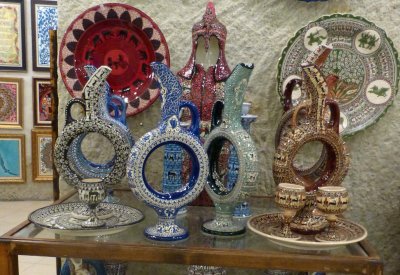
Wine jugs are based on the Hittite design from 4,000 years ago |

Some unique pottery from Omurlu Ceramics |

Another amazing pottery piece at Omurlu Ceramics |

A framed pottery piece at Omurlu Ceramics |
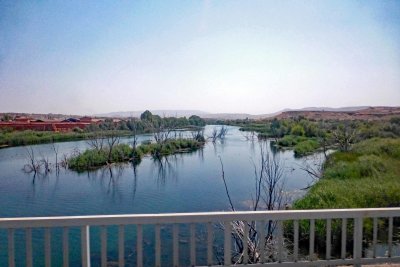
The Kızılırmak (Red River ) is the longest river in Turkey and supplies the red clay for pottery |

Susan in front of an 'evil eye' tree |

Uchisar (means 'Outer Citadel') is a village in the Cappadocia region of Turkey |

Uchisar 'Castle' was the main point of defense for the Cappadocia region in the 15th and 16th centuries |

Unforgettable restaurant where we learned that our flight home was cancelled |

Not all of Cappadocia is caves and fairy chimneys |
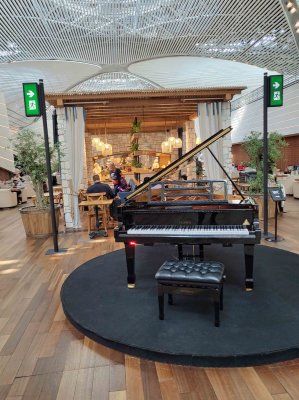
Player grand piano in Turkish Air Business Lounge in Istanbul |
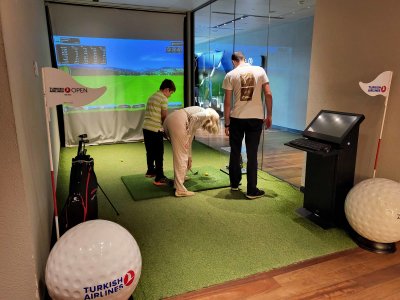
Golf Simulator in Turkish Air Business Lounge in Istanbul |
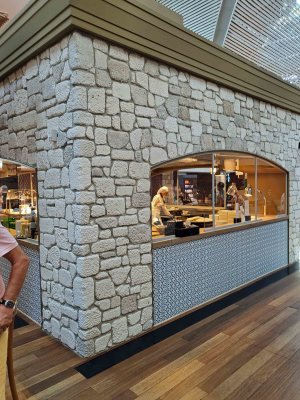
One of 20 food and drink stations in the Turkish Air Business Lounge in Istanbul |
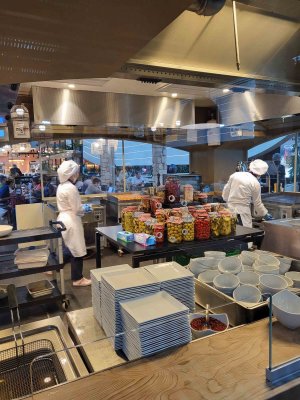
On-site food preparation at Turkish Air Business Lounge in Istanbul |
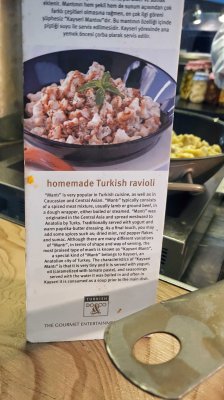
Turkish and international dishes are available in the Turkish Air Business Lounge in Istanbul |

Kids enjoying the Turkish Air Business Lounge in Istanbul |

Turkish Airlines has an onboard chef in Business Class |











